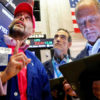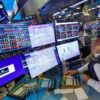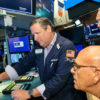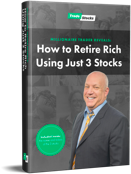
Powell insists Fed is not out of fire power to support the economy
After a two-day meeting, Fed officials pledged again to use its full range of tools to try to help the economy thrive despite the coronavirus pandemic.
In a statement, Fed officials said economic activity has “continued to recover,” but remains well below pre-pandemic levels.
Despite signs of moderation in activity, Powell said it looked like the worst-case scenarios for the economy have been avoided.
Fed watchers did not expect any action from the Fed on Thursday, saying the meeting was too close to the presidential election. The fact that the winner of the election is still unknown was seen as all the more reason to remain cautious. But many see the Fed taking more easing action before the end of the year.
“The FOMC stayed fully out of the way of the election this afternoon. The tone of the press conference leaned toward continuing to do more. Markets shook off the communications,” said Derek Holt, head of capital market economics at Scotiabank Economics.
The panel left its benchmark rate in a range of 0-0.25%. The Fed said it would maintain its asset purchases at least at the current pace of $120 billion per month.
There were no dissents from the Fed decision.
The Fed statement said again that the path of the economy will depend significantly on the course of the pandemic. Powell said this all remained “highly uncertain.”
The U.S. counted a record of more than 100,000 new cases of the coronavirus illness COVID-19 on Wednesday, the most in a single day since the start of the outbreak. The rise in new cases “is particularly concern,” the Fed chairman said.
The Fed cut interest rates close to zero in March and many observers think the central bank is low on ammunition to help the economy.
During the press conference, Powell pushed back on this idea.
“Is monetary policy out of power? The answer to that would be no,” Powell said.
At several points during the press conference, Powell again urged Congress to pass the fourth stimulus relief measure. This would help counter the risk of the spread of the virus and the expiration of benefits for many unemployed workers, he noted.
“I do think fiscal policy is absolutely essential here,” he said.
Asked if lawmakers were “hearing” him, Powell essentially said yes.
The Fed is keeping rates low across the yield curve in part by saying it doesn’t plan to raise its benchmark interest rate for at least the next three years.
Analysts think Congress will eventually pass another stimulus measure but the size and scope depends on the outcome of the election.
The Fed is purchasing $120 billion per month of Treasurys and mortgage-related debt in an effort to keep financial markets stable and support the economy. The purchases also help to put downward pressure on the yield curve, which allows the government to borrow funds to pay for the coronavirus relief at low rates.
The Fed had a lengthy discussion about its asset purchases, Powell said, but was content to leave the program as is.
The economy grew at a record 33.1% annual rate in the July-September quarter, as activity sprang back to life after the March-April shutdown to try to stem the spread of the coronavirus.
A slowdown in the final quarter of the year is inevitable but economists are unsure how slow growth will be. Powell said there were signs the economy was moderating.
Economists surveyed by MarketWatch expect growth will slow to a 3.1% annual rate in the fourth quarter, which would be considered a strong quarter in pre-pandemic terms.
But some observers are worried growth could slow more sharply.
They think the Fed will try to boost the economy further by shifting its Treasury purchases to the long-end of the yield curve, perhaps as soon as the next Fed meeting on Dec. 15-16.
Asked what it would take to get the Fed to buy more bonds, Powell said he didn’t want to talk about hypotheticals.
“We understand there are a number of parameters where we can shift the composition, the duration, the size, the lifecycle of the program. All of those things are available to us as ways to deliver more accommodation,” he said.
“Right now, we like the amount of accommodation the program is delivering,” he said.
Part of the discussion about bond buying at the meeting “was how to think about those various parameters,” he said.
The central bankers did not discuss slowing the pace of asset purchases, he noted.
The Fed also has about a dozen lending programs to get credit to flow to all sectors of the financial markets. Most of these programs expire at the end of the year. Powell ducked questions about whether they would be extended.
The decision has to be made in coordination with the Treasury Secretary, who may be a lame-duck.
Stocks held onto earlier gains after the Fed decision, with the Dow Jones Industrial Average DJIA, +1.94% closing up about 1.9%.

















